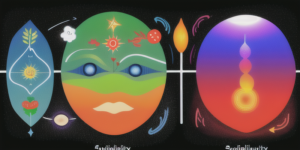The idea that one can be “addicted to suffering” seems paradoxical, if not utterly absurd, at first glance. After all, who would willingly choose discomfort, pain, or agony? Yet, the reality is that the human psyche can develop a complex, symbiotic relationship with its suffering. Therein lies a strange attraction; an allure that paradoxically offers both torment and solace.
Consider a depressive individual, cloaked in a dark shroud of melancholy, who has lived so long within the recesses of their suffering that they’ve become oblivious to its ominous presence. They’ve formed a bond with their depression, making it an integral part of their identity. This relationship can be likened to living in a house surrounded by a sea of flames. The inferno rages on relentlessly, threatening to consume everything in its path. It is terrifying and destructive, yet this tormented individual finds refuge within it.
This ‘house’ is their sanctuary, their safe haven amid the blaze. Though the world outside is engulfed in fire, inside the house, there’s a semblance of safety. Fear lurks in every corner, yet a strange comfort blankets them within this safehouse. It’s their haven amidst the chaos; the eye of the storm.
Now, think of this house as the human mind ensnared by its suffering. The flames represent the anguish that surrounds it, but the house remains intact, offering an illusory shelter. It’s not that the person enjoys the suffering; rather, they find solace in the familiarity. The walls of the house are built with bricks of routine and despair, yet within these walls, there is a distorted sense of security. Over time, this house, despite being engulfed in flames, becomes a place of refuge. It’s not that the flames are welcoming, but the house in the midst of this hellfire is strangely comforting.
Over time, the suffering becomes a familiar landscape. The burning fires of agony are terrifying, but the house within which they’ve taken refuge, their internal world filled with habitual suffering, starts to feel safe. It’s still daunting, but it becomes home. This familiarity gradually transforms into addiction. The individual gets hooked on the habitual suffering, and stepping outside of this ‘house’ feels much scarier than living within it. It’s the fear of the unknown that keeps them tethered to their suffering.
This concept might be reminiscent of the allegory of the cave wherein the prisoners are shackled, only able to perceive the shadows on the cave wall. They mistake these shadows for reality because it’s all they’ve ever known. Similarly, those addicted to suffering mistake their pain for reality, not realizing that there is a world outside of their suffering.
The truth is that no house, no matter how comforting, can shield one entirely from the blazing fires of suffering. True safety lies not in the retreat within these walls, but in the courage to step out and face the blaze. It involves taking the plunge into the unknown, confronting the daunting reality of their situation, and taking necessary steps to extinguish the flames.
The first step towards liberation from suffering is to be aware of it. Awareness is the key to unlocking the door of the safehouse and stepping out into the blaze.The way out is by embracing the suffering and walking through the fire, one can transcend it.
This teaching underscore the importance of breaking the cycle of habitual suffering. While it is easier to remain within the safe confines of the house, the flames of suffering can only be extinguished when one gathers the courage to face them head-on.
Suffering, as terrifying as it may seem, is not a house to take refuge in, but a fire to walk through. Only by walking through the fire can one truly understand it, overcome it, and, eventually, put it out. But, as long as one stays in the ‘safehouse,’ they’ll remain trapped within the confines of their suffering.
As paradoxical as it sounds, addiction to suffering is a very real phenomenon. But remember, as long as there’s a fire, there’s also the possibility of rain. The key to overcoming suffering lies not in retreating to the illusory safety of the ‘house,’ but in having the courage to walk through the blaze, face the suffering, and, ultimately, extinguish it.
In sum, the concept of being addicted to suffering highlights the complex and often misunderstood relationship between the human psyche and suffering. It is a complex bond that is rooted in familiarity and fear of the unknown, creating a seemingly insurmountable obstacle to liberation. Nonetheless, through awareness, an individual can disrupt the pattern of customary distress, entering a realm unburdened by the chains of agony.
Being addicted to suffering is a deceptive comfort zone built on the familiarity of pain and fear of the unknown. Recognizing this unhealthy attachment is the first key step towards liberation.





